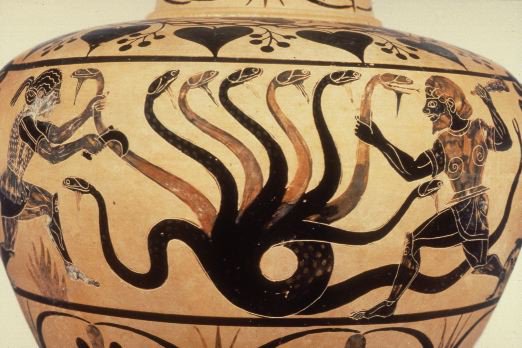Well, OK. So it’s not THAT unique an idea - but what the heck. This is my blog. :P
Let’ start things off with one of my favorite creatures from Greek Mythology - the Hydra.
Heracles (or Hercules to the Romans) was a great and tragic Greek hero. He was the son of Zeus (Lord of Olympus and the god of thunder) and a mortal woman named Alcmena. Zeus’ wife Hera, furious at her husband’s infidelity, set about to destroy the half-god from the moment of his birth. At each deadly encounter, Heracles managed to avoid death. When he reached adulthood, Hera (goddess of women and marriage) found her chance. She put madness into Heracles’ head that resulted in him killing his own children. To repent for the crime, Heracles set off to complete a series of tasks commonly called “The Labors of Heracles.” The second of these labors was to kill the Lernean Hydra.
Stories vary depending on the author and time period, so here I’ll recount my favorite version.
The Hydra was a reptilian beast, serpentine in nature, with nine heads and a venomous bite. To make the matter more complicated, one of the heads was immortal. To lure the creature out of hiding, Heracles shot flaming arrows into the beast’s lair. Once exposed, he battled with the monster in hand to head combat. Some variations indicate the central head spewed fire, which would have certainly complicated matters.
Like any good mythological story, there are so many variations, it’s hard to keep track. Some stories make this monster as big as a house. Others depict is as little more than a dog-size reptile. Regardless of its physical size, this thing was lethal.
 As Heracles severed each head from the monster’s body, his horror multiplied. For each head killed, two grew back in its place. This symbolized the hopelessness of his task and the increasing likelihood of the hero’s death. Talk about upping the ante of a conflict! He eventually discovered a solution. As he removed each head with his sword, he used a flaming brand to cauterize the wound. This prevented the head from growing two more anew. But, the deadly central head, which was immortal, could not be killed so easily. It’s unclear if Heracles severed the head and then buried it beneath a bolder or if he buried the entire remaining monster. But, what we do know is that this was one tough mythological monster.
As Heracles severed each head from the monster’s body, his horror multiplied. For each head killed, two grew back in its place. This symbolized the hopelessness of his task and the increasing likelihood of the hero’s death. Talk about upping the ante of a conflict! He eventually discovered a solution. As he removed each head with his sword, he used a flaming brand to cauterize the wound. This prevented the head from growing two more anew. But, the deadly central head, which was immortal, could not be killed so easily. It’s unclear if Heracles severed the head and then buried it beneath a bolder or if he buried the entire remaining monster. But, what we do know is that this was one tough mythological monster.

The hydra story with Hercules is one that really stuck with me when I was a kid. Looking forward to other mythical creature discussions.
ReplyDeleteTo me, one of the most fascinating parts of myth is that different ancient authors wrote about these things from different points of view. Virgil would say one thing and then Homer would contradict that thing with something similar.
ReplyDeleteUltimately, we have to read through the information available and then select what we like. :) SO, I expect some of these little tid bits will be out of alignment with many folk’s perceptions and what they may have previously learned.
*shrug* Such is the nature of myth.